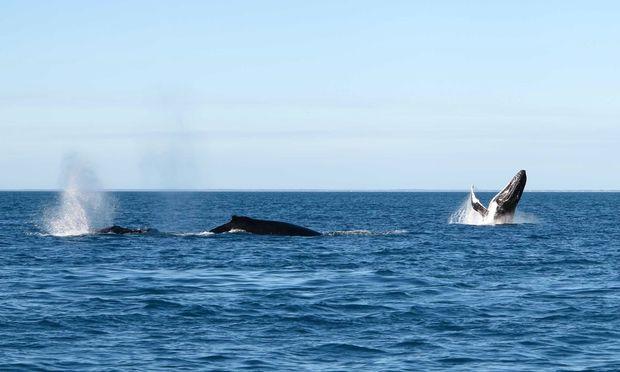How pop music helped save the whales
Whales off the coast of Gantheaume Point, Australia
Only one non-human species has ever had a hit record: whales. When whales were first recorded, they became really big.
In 1970, when Judy Collins recorded the album Whales and Nightingales, she included a song called Farewell to Tarwathie, in which she sang along with the sounds of whales, creating a haunting duet. The record went gold and it introduced millions to the songs of the humpback whales.
Collins had been given a recording of the whales by biologist Roger Payne. Payne, in turn, had obtained the recordings from sound engineer and military researcher Frank Watlington. While trying to record undersea dynamite explosions, Watlington heard haunting sounds and recorded them. He wasn’t even sure what he was hearing. Payne credits Watlington for having the presence of mind to make the recordings and hang on to them.
At that point, very little was known about the sounds whales made, or why they made them. When Payne brought the recordings back to his office in New York, he was transfixed. “These sounds are without exception … the most provocative, most beautiful sounds by any animal on earth,” he says. He played them over and over, until, without even being aware, he had memorized them. “After a long while of listening,” Payne says, “I suddenly realized: My God, this thing is repeating itself."
This was a startling discovery. If an animal repeats a sounds, as a bird or a cricket does, it’s technically considered a song. These, however, were arguably the most complex songs of any animal. They were 10 minutes long or more and there was no break before they repeated.
At the time, whales were being hunted to extinction. Payne saw the songs as a call to arms. For the next two years, Payne spent as much time distributing these recordings as studying them. He gave them to musicians, composers and singers.
“What I wanted to do was try to build them into human culture,” he explains. “Anything — any damn thing that anybody wanted to try, that seemed fine to me.” That’s when he found Judy Collins.
It was the summer of 1969. He introduced himself to her backstage at a performance and handed her a small package. Inside was the reel-to-reel tape of the whale songs. Collins took it home and listened.
“It was very emotional,” she says. “[I felt] angst for being a human being on a planet where they also live; guilt for doing what we do to them. … They’re so smart, and they've been here for so long, and they certainly might have some insights about what we could do to live a better way.”
In 1970, Collins released Whales and Nightingales. She devoted a portion of the royalties to Payne's conservation work. Soon after, Capitol Records released Payne's recordings of humpback whales songs. It’s still the best selling natural sounds album of all time. And just as Payne had hoped, these strange mournful sounds inspired a movement: Save the Whales. By 1972, The United States had banned all whaling and whale products.
George Lipsitz, an American Studies professor at the University of California, Santa Barbara, says the songs of the whales struck a nerve because they were part of a historical moment. The US had just experienced the Kent State Shootings; the Vietnam war seemed like it would never end; Martin Luther King had been killed. Lipsitz says people were questioning the very notions of progress and civilization.
There was a suspicion, he says, "that maybe we learn that meanness and that cruelty by establishing rigid boundaries between the human and the animal, and between culture and nature.” People were asking questions like, “what if human guile cuts us off from essential relations to other species,” he says. “It’s almost like we were each hoping for a kind of magic to conjure a new world into being.”
Today, it seems, that kind of idealism doesn’t exist much anymore. Humpback whales no longer sell the number of records they did back in the 1970s. But these haunting calls continue to intrigue scientists and musicians alike.
In 2001, whale researcher and musician Lisa Walker went to humpback whale feeding grounds in Alaska. Using an underwater speaker and a microphone, she piped her violin down among the singing whales, captured the results and then created an album called Grooved Whale.
Scientists remain mystified by the whales’ complex songs — what information they convey, why they evolve. Musicians, on the other hand, continue to find their own way of going deep below the surface.
This story first aired on PRI's Studio 360, reported by Michael May
